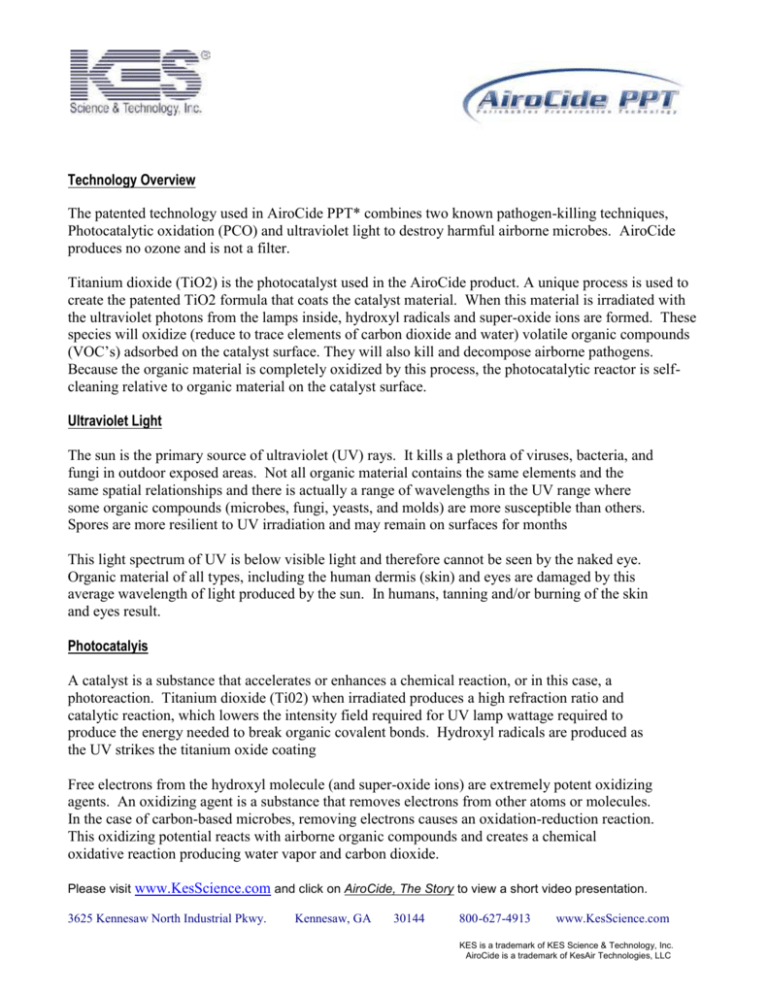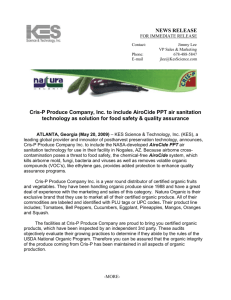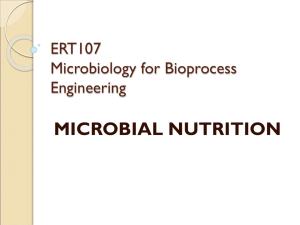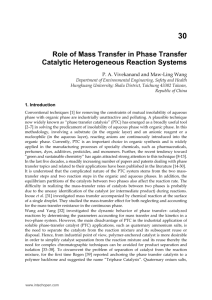PPT Technology Overview 3 - KES Science and Technology, Inc.
advertisement

Technology Overview The patented technology used in AiroCide PPT* combines two known pathogen-killing techniques, Photocatalytic oxidation (PCO) and ultraviolet light to destroy harmful airborne microbes. AiroCide produces no ozone and is not a filter. Titanium dioxide (TiO2) is the photocatalyst used in the AiroCide product. A unique process is used to create the patented TiO2 formula that coats the catalyst material. When this material is irradiated with the ultraviolet photons from the lamps inside, hydroxyl radicals and super-oxide ions are formed. These species will oxidize (reduce to trace elements of carbon dioxide and water) volatile organic compounds (VOC’s) adsorbed on the catalyst surface. They will also kill and decompose airborne pathogens. Because the organic material is completely oxidized by this process, the photocatalytic reactor is selfcleaning relative to organic material on the catalyst surface. Ultraviolet Light The sun is the primary source of ultraviolet (UV) rays. It kills a plethora of viruses, bacteria, and fungi in outdoor exposed areas. Not all organic material contains the same elements and the same spatial relationships and there is actually a range of wavelengths in the UV range where some organic compounds (microbes, fungi, yeasts, and molds) are more susceptible than others. Spores are more resilient to UV irradiation and may remain on surfaces for months This light spectrum of UV is below visible light and therefore cannot be seen by the naked eye. Organic material of all types, including the human dermis (skin) and eyes are damaged by this average wavelength of light produced by the sun. In humans, tanning and/or burning of the skin and eyes result. Photocatalyis A catalyst is a substance that accelerates or enhances a chemical reaction, or in this case, a photoreaction. Titanium dioxide (Ti02) when irradiated produces a high refraction ratio and catalytic reaction, which lowers the intensity field required for UV lamp wattage required to produce the energy needed to break organic covalent bonds. Hydroxyl radicals are produced as the UV strikes the titanium oxide coating Free electrons from the hydroxyl molecule (and super-oxide ions) are extremely potent oxidizing agents. An oxidizing agent is a substance that removes electrons from other atoms or molecules. In the case of carbon-based microbes, removing electrons causes an oxidation-reduction reaction. This oxidizing potential reacts with airborne organic compounds and creates a chemical oxidative reaction producing water vapor and carbon dioxide. Please visit www.KesScience.com and click on AiroCide, The Story to view a short video presentation. 3625 Kennesaw North Industrial Pkwy. Kennesaw, GA 30144 800-627-4913 www.KesScience.com KES is a trademark of KES Science & Technology, Inc. AiroCide is a trademark of KesAir Technologies, LLC







